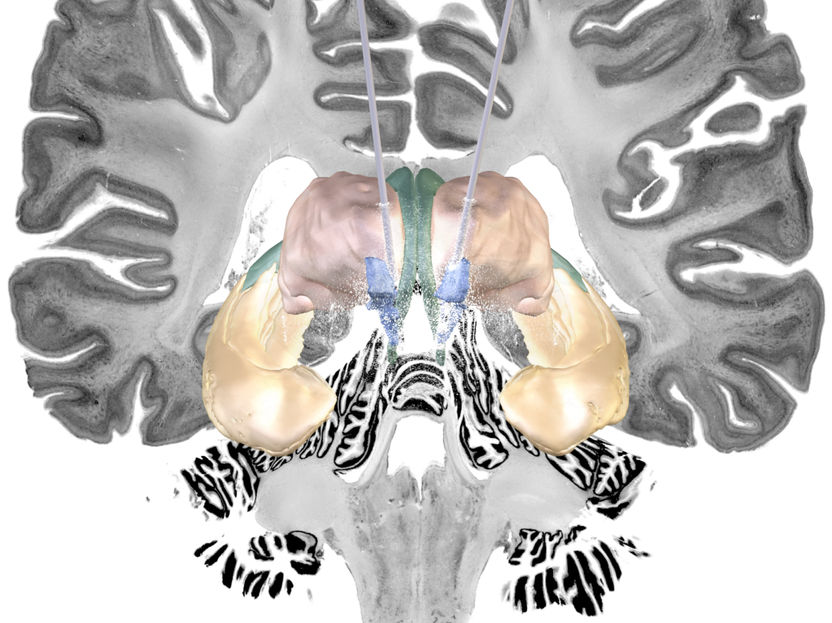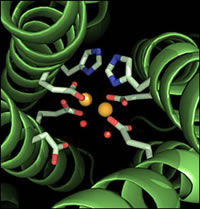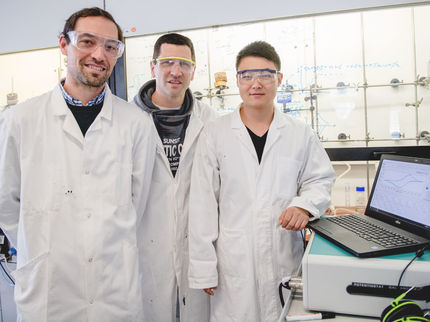Newly found DNA catalysts cleave DNA with water molecule
Better tools for manipulating DNA in the laboratory may soon be possible with newly discovered deoxyribozymes (catalytic DNA) capable of cleaving single-stranded DNA, researchers at the University of Illinois say. The deoxyribozymes accomplish the DNA cleavage with the sequence-selectivity and site-selectivity required for a practical catalyst.
"Our work suggests that deoxyribozymes have significant potential as sequence-specific DNA cleavage reagents," said chemistry professor Scott Silverman. "The hope is that we can take this fundamental advance and develop the ability to use DNA as a practical catalyst to cleave double-stranded DNA."
Silverman, postdoctoral research associate Madhavaiah Chandra and graduate student Amit Sachdeva report their discovery in a paper for Nature Chemical Biology. The researchers discovered the new deoxyribozymes while searching for artificial sequences of DNA that could cleave proteins. The newly found catalysts function in a fashion similar to restriction enzymes, although to date by cleaving only single-stranded DNA.
Restriction enzymes, which allow scientists to cut and paste portions of double-stranded DNA, are the fundamental catalysts of molecular biology. Each restriction enzyme, however, has a limited number of DNA sequences it can cut. Consequently, only a few percent of arbitrarily chosen DNA sequences can be cut by commercially available restriction enzymes. Like natural restriction enzymes, the new catalysts are both sequence-specific and site-specific.
"This means we can target a particular sequence, and we know we will cut at only one site within that sequence," Silverman said. "By appropriately picking the recognition and enzyme regions of the catalyst, we should be able to cut many more DNA sequences than is possible with current restriction enzymes."
The new DNA catalysts require two metal ions – manganese and zinc – to carry out their catalysis, "which is intriguing, because many natural protein-based nucleases (which cleave DNA) similarly require two metal ions," Silverman said. "One or both of the metals are presumably involved in the chemical mechanism by which our DNA catalyst achieves hydrolysis of the DNA backbone."
DNA hydrolysis is a very challenging chemical reaction, much more difficult to perform than the cleavage of a strand of RNA, Silverman said. In cleaving DNA, a water molecule must be brought in for the breaking reaction to occur. Also, both the DNA and the catalyst must be arranged appropriately in three-dimensional space.
How all of this happens with the DNA catalysts is not yet clear. Silverman's research group continues to probe the structure and mechanism of the catalysts, along with identifying and characterizing catalysts with different recognition sites.
"So far, we have achieved cleavage of single-stranded DNA targets," Silverman said. "The next big step is to cleave double-stranded DNA targets."
Topics
Organizations
Other news from the department science

Get the life science industry in your inbox
By submitting this form you agree that LUMITOS AG will send you the newsletter(s) selected above by email. Your data will not be passed on to third parties. Your data will be stored and processed in accordance with our data protection regulations. LUMITOS may contact you by email for the purpose of advertising or market and opinion surveys. You can revoke your consent at any time without giving reasons to LUMITOS AG, Ernst-Augustin-Str. 2, 12489 Berlin, Germany or by e-mail at revoke@lumitos.com with effect for the future. In addition, each email contains a link to unsubscribe from the corresponding newsletter.
More news from our other portals
Last viewed contents
Dow and greenovation will collaborate on glycosylation research for transgenic plant systems
Urine analysis enables cardiovascular risk assessment

Brain stimulation could help treat Alzheimer’s disease - Study discovers brain network that alleviates symptoms when stimulated
Sartorius reviews fiscal 2008 - Different outlook for the two Group divisions
Sanofi licenses worldwide rights on regenerative treatment for osteoarthritis and cartilage disorders from Scil Technology
Roche Diagnostics Announces Dan Zabrowski as New Head of Roche Applied Science
LUX biotechnology wins the Pfizer Award for Innovation
Bausch & Lomb and Galapagos sign agreement to collaborate on ophthalmic disease research

And the winner is …. cancer research
Eurofins expands its footprint in Asia with the acquisition of Lab Frontier in South Korea






















































